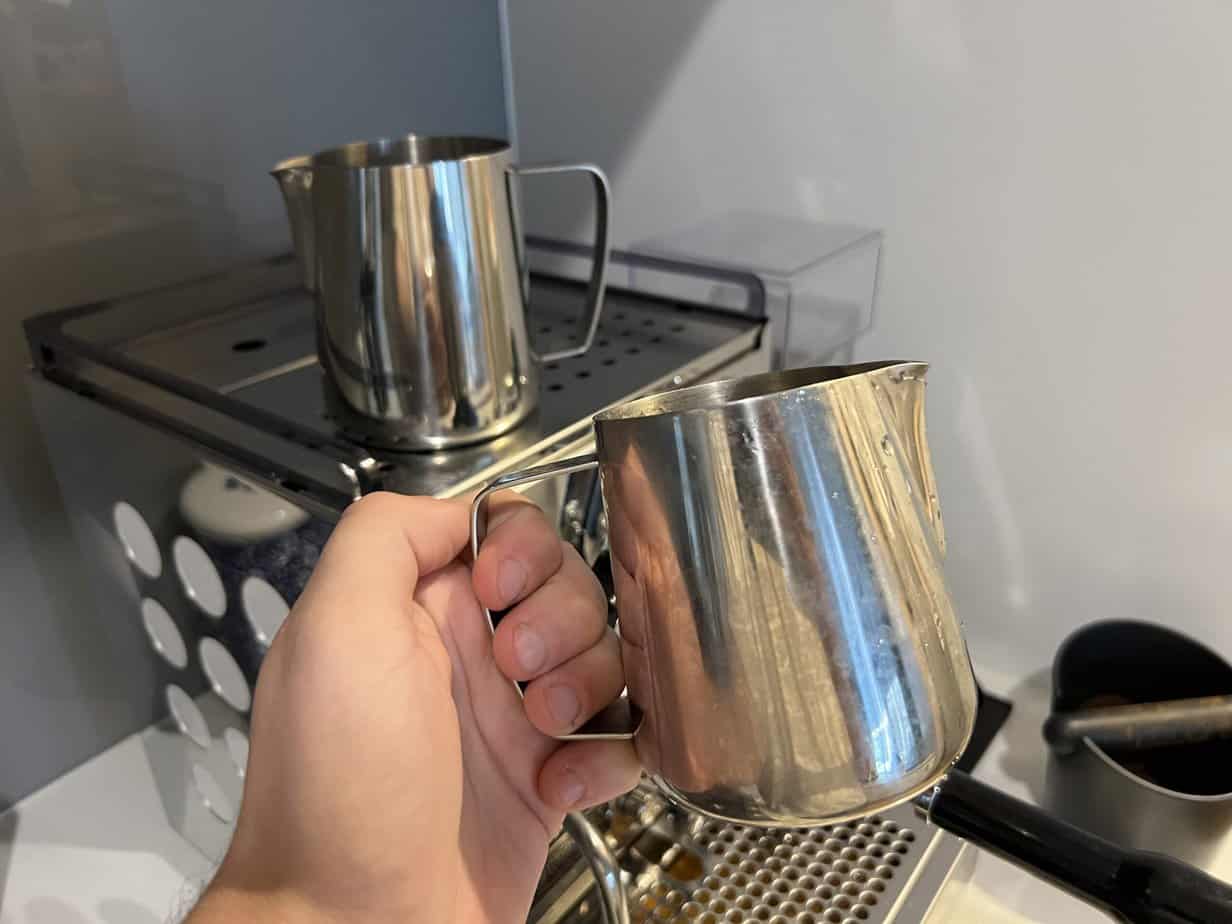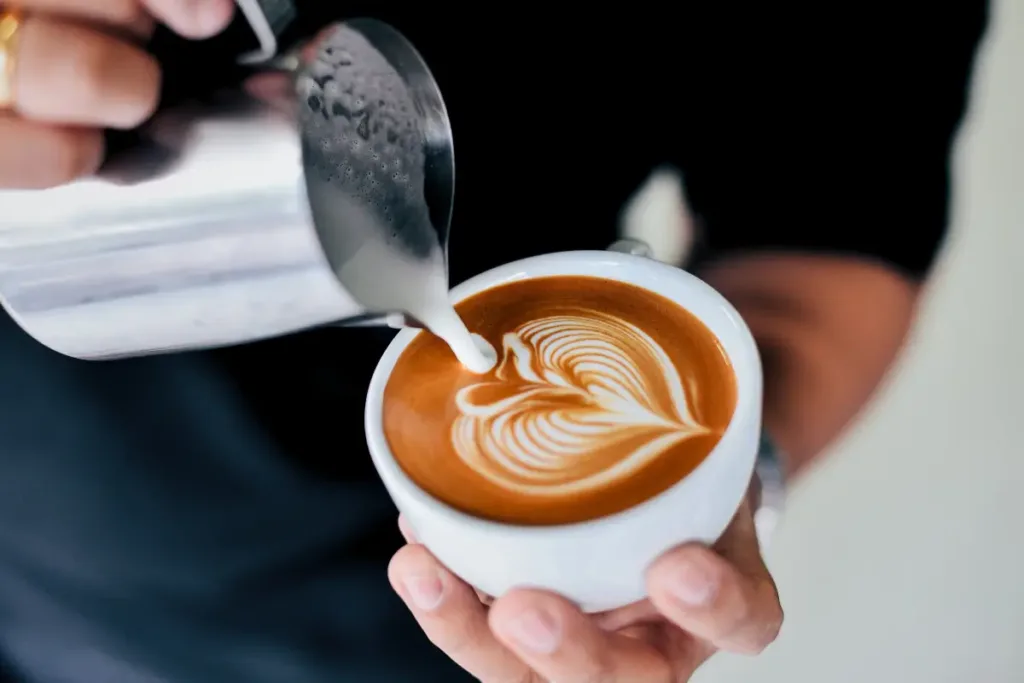Creating beautiful latte art requires more than just skill. The size of your milk pitcher plays a crucial role too.
Choosing the right milk pitcher size can make a big difference in your latte art results. If you’re passionate about perfecting your coffee designs, understanding the best pitcher size is essential. A well-sized pitcher helps in achieving the right milk texture and pouring precision.
This guide will help you discover the best milk pitcher size for creating stunning latte art. Whether you are a beginner or a seasoned barista, finding the right tools can elevate your coffee game. Let’s dive into how the pitcher size impacts your latte art and what size you should consider.
Choosing The Right Size
Choosing the right size for your milk pitcher is crucial for creating perfect latte art. The size of your pitcher can greatly impact your ability to control the pour and texture of the milk. Let’s explore why size matters and the common sizes available.
Importance Of Size
The size of your milk pitcher plays a key role in achieving the ideal milk texture and consistency. A smaller pitcher allows for more precise control, making it easier to create intricate latte art patterns. On the other hand, a larger pitcher can hold more milk, which is useful for making multiple drinks at once.
Using the correct size ensures you can properly steam the milk. This affects the microfoam quality, which is essential for beautiful and smooth latte art. Too much milk in a small pitcher can lead to overflow and inconsistent foam. Too little milk in a large pitcher makes it hard to achieve the right texture.
Common Sizes Available
Milk pitchers come in various sizes to suit different needs. Here are some of the most common sizes:
| Size (oz) | Best For |
|---|---|
| 12 oz | Single cappuccino or latte |
| 16 oz | Single large latte or two small drinks |
| 20 oz | Two medium-sized lattes |
| 32 oz | Multiple drinks or large beverages |
A 12 oz pitcher is ideal for a single cappuccino or latte. It allows for precise control, which is perfect for detailed latte art. A 16 oz pitcher is versatile, suitable for a large latte or two smaller drinks.
The 20 oz pitcher works well for making two medium-sized lattes. Finally, a 32 oz pitcher is best for baristas who need to create multiple drinks quickly or for large beverages.
Choosing the right size depends on your specific needs and drink preferences. Consider how many drinks you usually make at one time and the level of detail you want in your latte art.
Benefits Of A 12oz Pitcher
The 12oz milk pitcher offers several benefits for latte art. It is a popular choice among baristas and coffee enthusiasts. This size strikes a perfect balance between capacity and control. Whether you are making a single latte or practicing your pouring skills, a 12oz pitcher can be a great tool. Let’s explore the benefits it offers.
Ideal For Single Lattes
A 12oz pitcher is ideal for making a single latte. It holds the right amount of milk for one serving. This size helps in reducing milk wastage. You can precisely measure and steam the perfect quantity.
For home baristas, it simplifies the process. You don’t need to worry about leftover milk. It also ensures consistent results.
Control And Precision
Smaller pitchers provide better control over your pour. A 12oz pitcher allows you to handle the milk easily. It helps in achieving the right texture. This size is perfect for creating detailed latte art. The spout design in most 12oz pitchers is also optimized. It aids in guiding the flow of milk accurately. You can create intricate patterns with ease.
Advantages Of A 20oz Pitcher
The 20oz milk pitcher is a favorite among baristas and home enthusiasts. This size offers unique advantages that can improve the latte art experience. Let’s dive into some key benefits that make the 20oz pitcher a top choice.
Suitable For Multiple Lattes
The 20oz pitcher can steam enough milk for two or more lattes. This is perfect for serving friends or family. You can create multiple drinks without reheating milk. It saves time and makes the process smoother.
Versatility In Use
This pitcher size is versatile for different drinks. It’s not just for lattes. You can use it for cappuccinos, flat whites, or hot chocolates. The larger size gives you the freedom to experiment. It can help you perfect your steaming technique.
Many baristas prefer a 20oz pitcher for practice. The extra space allows for better control. You can achieve the right texture for microfoam. This is essential for creating intricate latte art designs.

Credit: www.latteartguide.com
When To Use A 32oz Pitcher
When creating latte art, the right milk pitcher size is crucial. A 32oz pitcher might seem large, but it has specific uses. Understanding when to use it can improve your coffee-making experience.
For High Volume Needs
A 32oz pitcher is ideal for high-volume needs. If you are making several lattes, this size helps. You can steam enough milk for multiple drinks at once. This saves time and ensures consistency in each cup.
Using a larger pitcher is practical in busy coffee shops. Baristas can prepare milk for two or three lattes in one go. This keeps the workflow smooth and customers happy.
Challenges Of Larger Pitchers
While a 32oz pitcher is useful, it has challenges. It can be harder to control the pour. Precision is key in latte art, and larger pitchers may make this tricky. The weight of a full 32oz pitcher can also be a factor. It might be tiring to handle for long periods.
Larger pitchers may also require more practice. New baristas might struggle with them at first. It’s important to develop a steady hand and good technique.
Here is a quick comparison of different pitcher sizes and their uses:
| Pitcher Size | Best For | Challenges |
|---|---|---|
| 12oz | Single Latte | Limited Milk Amount |
| 20oz | Two Lattes | Moderate Control Needed |
| 32oz | Multiple Lattes | Harder to Control |
In summary, a 32oz pitcher is great for high-volume needs. But it requires skill and practice to handle effectively.
Material Considerations
Choosing the best milk pitcher for latte art involves considering the material. The right material affects heat control, durability, and ease of use. Below, we discuss popular materials for milk pitchers.
Stainless Steel Options
Stainless steel is a popular choice for milk pitchers. It is durable and easy to clean. Stainless steel pitchers come in various sizes, from 12 oz to 20 oz. These pitchers are resistant to rust and staining. They also conduct heat well, helping to steam milk evenly.
| Size | Benefits |
|---|---|
| 12 oz | Perfect for single servings |
| 20 oz | Ideal for multiple cups |
Many baristas prefer stainless steel for its balance. The weight helps control the pour. The spout design often helps create better latte art. Some stainless steel pitchers also have measurement marks inside. This helps you pour the right amount of milk.
Other Material Choices
While stainless steel is common, other materials are available.
- Ceramic: Ceramic pitchers are heavier. They retain heat well but can be fragile.
- Glass: Glass pitchers let you see the milk froth. They are easy to clean but can break easily.
- Plastic: Plastic pitchers are lightweight and affordable. They do not conduct heat well. This can make it harder to steam milk correctly.
Each material has pros and cons. Your choice depends on your needs and preferences. Consider durability, ease of cleaning, and heat retention.

Credit: perfectdailygrind.com
Spout Design Impact
Spout Design Impact plays a crucial role in creating beautiful latte art. The spout design of a milk pitcher can significantly affect your ability to control the milk flow and create intricate designs. Understanding the differences between narrow and wide spouts can help you choose the best milk pitcher for your latte art needs.
Narrow Vs. Wide Spouts
A narrow spout focuses the milk flow into a thin stream. This gives you more control over detailed designs. Narrow spouts are ideal for creating intricate patterns such as hearts and rosettas.
On the other hand, a wide spout produces a thicker stream of milk. This is beneficial for creating broader designs and filling in larger areas. Wide spouts work well for simple shapes and quick pours.
| Spout Type | Best For |
|---|---|
| Narrow Spout | Detailed designs |
| Wide Spout | Broader designs |
Effect On Pouring Techniques
The spout design affects your pouring techniques in multiple ways. A narrow spout requires a steady hand and slow, precise movements. This control allows you to create fine lines and detailed art.
Using a wide spout involves faster pours and wider movements. This makes it easier to fill large spaces quickly. Wide spouts are forgiving for beginners learning latte art.
Both spout designs have their advantages. Choose based on your skill level and desired latte art style. Whether you prefer detailed designs or broad, bold shapes, the right spout will enhance your latte art experience.
Handle Ergonomics
Handle ergonomics play a crucial role in selecting the best milk pitcher for latte art. The handle’s design affects comfort, grip, and overall control, impacting the quality of your latte creations. Ensuring the right handle ergonomics can make a significant difference in your latte art journey.
Comfort And Grip
A well-designed handle provides a comfortable grip. This is essential for maintaining control while pouring. Look for handles that fit your hand size. Avoid handles that feel too bulky or too small. A good handle should allow for a secure grip without causing strain.
Some milk pitchers feature handles with a slight curve. This can enhance grip and comfort. Try holding the pitcher to see how it feels. This small test can prevent discomfort during longer latte art sessions.
Impact On Latte Art
The handle’s ergonomics directly impact your latte art quality. A comfortable handle allows for smooth, controlled pouring. This control is vital for creating intricate designs. Poor handle ergonomics can lead to shaky hands and uneven pours.
A consistent grip ensures consistent results. The handle should support steady hand movements. This stability is crucial for achieving clean lines and detailed patterns in your latte art. Choose a pitcher with a handle that feels natural in your hand. This will help you create beautiful, professional-looking designs.

Credit: amazon.com
Maintenance Tips
Proper maintenance of your milk pitcher ensures a longer lifespan and better latte art. A well-maintained pitcher performs better and is more hygienic. Let’s explore some key tips to keep your pitcher in top shape.
Cleaning And Care
Clean your milk pitcher immediately after each use. Rinse it with warm water to remove milk residue. Use a mild detergent and a soft sponge to wash it thoroughly. Avoid abrasive materials that can scratch the surface. Rinse again to ensure no soap remains. Let it air dry or dry it with a clean towel.
Longevity Of Your Pitcher
Proper care extends the life of your milk pitcher. Avoid extreme temperature changes to prevent metal warping. Store the pitcher in a dry place to avoid rust. Inspect for any signs of wear and tear. Replace the pitcher if you notice cracks or rust. Regular maintenance keeps your pitcher in good condition for years.
Frequently Asked Questions
What Is The Best Milk Pitcher Size For Latte Art?
The best milk pitcher size for latte art is typically 12 to 20 ounces. This size provides enough milk for creating intricate designs and gives you better control during pouring.
Does Pitcher Size Affect Latte Art Quality?
Yes, pitcher size affects latte art quality. A correctly sized pitcher offers better control over milk flow. This allows you to create more detailed and consistent designs in your latte.
Can I Use A Small Milk Pitcher For Latte Art?
You can use a small milk pitcher for latte art, but it may limit your control. Smaller pitchers are better for single servings and may not accommodate intricate designs.
How To Choose A Milk Pitcher For Latte Art?
Choose a milk pitcher with a comfortable handle and a precise spout. The pitcher should be stainless steel and sized between 12 and 20 ounces for optimal results.
Conclusion
Choosing the right milk pitcher size makes latte art easier. Smaller pitchers work well for single cups. Larger pitchers are great for multiple drinks. Practice is key to achieving beautiful designs. The right size can help improve your skills. Enjoy creating and sharing your latte art.
Happy brewing!

